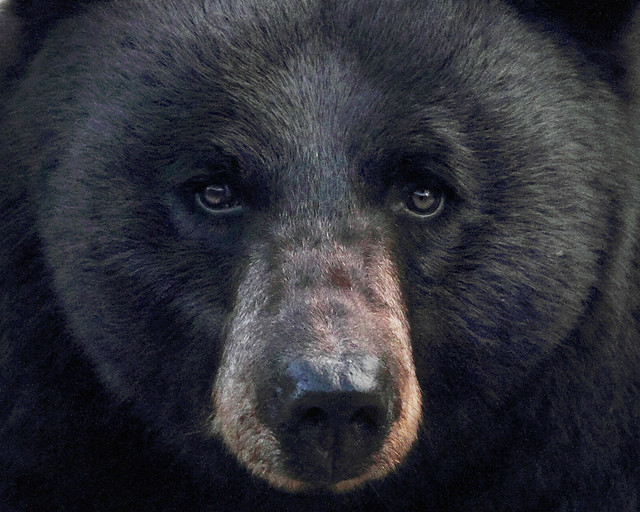Meet your new neighbor - carefully

Posted May 7, 2014 at 2:23PM
Having spent much of my life in and around the Smoky and Blue Ridge mountains, I’ve seen my share of black bears up close and personal. But in city environments, not so much, with perhaps one startling and ultimately embarrassing exception.
I was visiting family in my hometown of Asheville, North Carolina some years ago, and taking breaks by riding my bike. My parents lived in the city at the time, but just barely, and my usual route took me on a loop from their house, through the nearby countryside, and back through a different part of the city to their house again. My startling encounter was on what might be called a suburban road, but that’s not really accurate: it was more of a country road dotted with houses just outside the city limits. Nothing there was built as a suburb, really. The road took me past the houses on a gentle downward slope, so I was probably going 20mph or so.
The first time I passed, I had an unsettled feeling, but couldn’t quite say why. The next time, a day or two later, it was more pronounced – jeez, were those black blobs bears?? My pace required me to keep my eyes on the road, and I had seen something only in my peripheral vision. As most cyclists know, encountering dogs is bad enough when you’re on a bike. But bears?
As it turned out, the joke was on me. I drove part of the route on another day, and I saw that one of the houses had bear-shaped and –sized lawn ornaments in the front yard. Altogether, about five black bear silhouettes perfectly designed to scare the hell out of a DC-based cyclist.
False alarm. But a recent story by Sabian Warren in the Asheville Citizen-Times clarifies that real bears are actually now rather common in the city and its nearby surroundings. And it turns out they are especially fond of the suburbs:
“Bear numbers slowly began to increase after 1970, then accelerated about a decade ago partly because of increased land development, [state wildlife biologist Mike] Carraway said. New housing developments create de facto sanctuaries, he said . . .
“Bears are opportunistic omnivores, quickly learning how to take advantage of any food source available and how to live in close proximity to humans, he said. The animals can live up to 30 years, with the main causes of mortality being hunting and vehicle collisions.”
A new study is seeking to learn more about the bears that come into Asheville. According to Warren’s story, biologists have set out a dozen baited “culvert traps” — large metal containers with a door that shuts when a bear goes inside — in and around Asheville, all on private land with landowners' cooperation. Captured bears will be tranquilized to allow researchers to attach GPS collars and then released unharmed a short time later. The researchers hope to collar about 40 bears, studying their movements for three years, after which the collars will be released remotely.
During the study, the collars will update biologists about each bear's location every 15 minutes:
“Researchers will be able to determine whether bears spend all of their time in the city or come and go depending on food supplies. It will tell them what bears eat, including whether they are supplementing natural foods by raiding garbage cans, bird feeders and other human sources of food . . .
“Biologists also will be able to track female bears to their dens to learn more about den sites and reproduction rates, getting a better idea of the number of bears in the city.”
A smaller study based in Nevada, published in the fall 2008 issue of the journal Human-Wildlife Conflicts, and reported on NBCnews.com found that bears that frequent urbanized areas tend to weigh an average of 30 percent more than bears in wild areas “due to a diet heavily supplemented by garbage.” Because of the additional weight, they also give birth earlier. But, ultimately, they do not fare well: “All 12 urban bears that were tracked were dead by age 10 due to vehicle collisions,” according to the report.
A report of the same study in Science Daily says that the attractiveness of human environments could actually be reducing bear populations in wilderness:
“The study warns that urbanized areas are functioning as ‘sinks’ for black bear populations, drawing in bears from outlying wild areas, where they ultimately die. As a result, bears are failing to re-colonize outlying wild areas following this shift to urban centers.”
John Roach wrote on National Geographic’s website that, while the ecological role of bears is poorly understood, biologists believe they may be important in decomposing felled logs, dispersing seeds of berries, and “removing rotting flesh from the forest floor.”
Check out this three-minute video produced by PBS in Anchorage, Alaska, to see glimpses of brown bears, which mostly avoid humans; black bears, which love our leftovers, enjoying suburban decks; and especially a mother black bear and her playful cubs cavorting on a golf course:
Finally, if you’re out on your bike in western North Carolina, be careful out there.
Move your cursor over the images for credit information.
Related posts:
- The many benefits of street trees and urban greenery (excerpted from People Habitat) (April 23, 2014)
- Has lousy planning contributed to “the lost wilderness of childhood”? (August 6, 2009)
- How a smarter streetscape is reviving a faded suburban district (December 9, 2013)
- Washington Post misses the point on suburban roads (September 12, 2013)
- Federal court says highway sponsors must first study transit, impacts on suburban sprawl (June 5, 2013)


